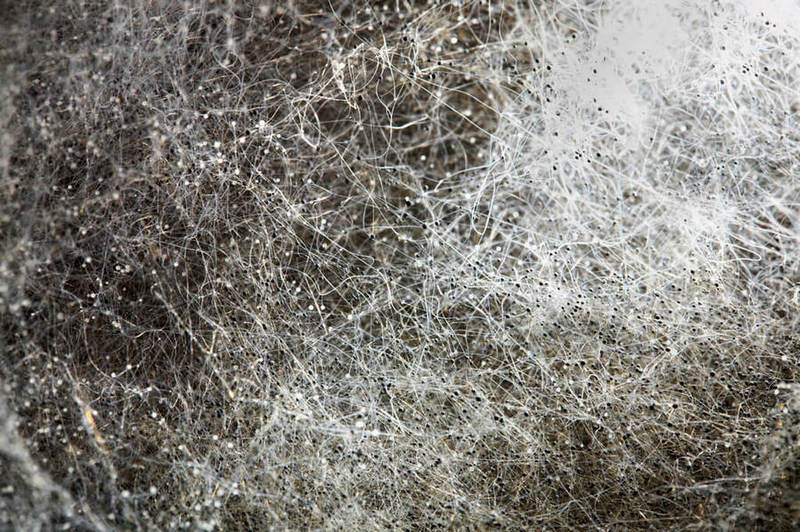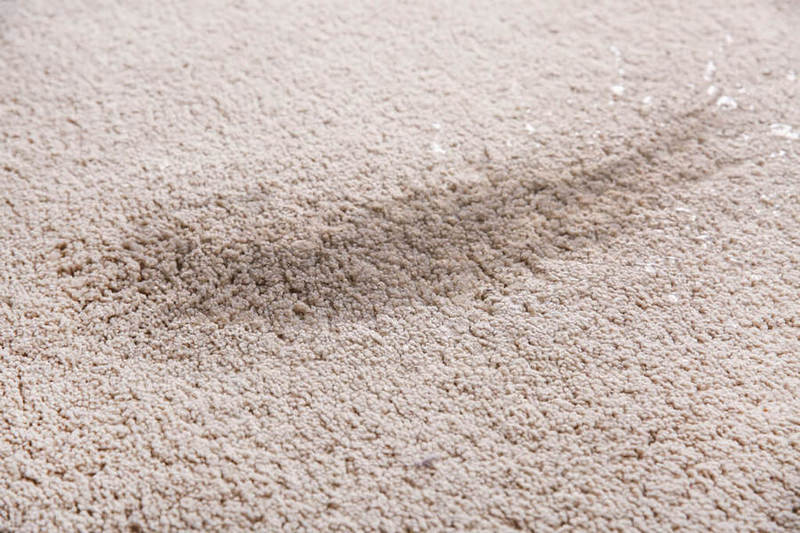The stringy and powdery white mold is a relatively lesser-known mold type but certainly not the one to be overlooked. It can wreak havoc on your home aesthetics and overall well-being if left unchecked for prolonged periods.
Although mold spores can land on any damp surface, carpets tend to attract them quickly because they absorb more moisture.
The white fuzzy mold discolors your carpet and leaves a nasty, unbearable odor on your property. Learn how to remove white mold from the carpet to ensure optimal hygiene and enjoy a clean indoor environment.
What is white mold?
White mold is a fungus that originates from different fungal species that appear green, gray, or white. Its texture is similar to mushrooms, and it may appear as a thin cotton or silk layer on damp surfaces.
White mold has filaments called hyphae that extend from its main body. They contain capillaries, allowing them to absorb nutrients from their surroundings. Like other mold types, white mold needs a favorable environment to grow and thrive.
For instance, it grows within 24-48 hours in homes with high humidity. You may spot it in the basement, crawl spaces, shower, walls, and carpets. Although humidity is a reason enough to encourage its growth, carpets that undergo water damage are more likely to be affected by white mold.

Why is white mold harmful?
The Centers for Disease Control and Prevention mentions that consistent exposure to mold can lead to adverse health effects. Unfortunately, the case isn’t any different with white mold.
Breathing in a white mold environment can be dangerous as it may lead to:
- Dizziness
- Shortness of breath
- Headaches
- Respiratory infections
- Skin and eye irritation
Even worse, someone with an existing health condition – think asthma – is at high risk. For instance, the symptoms of asthmatic patients may exacerbate due to white mold exposure.
Likewise, people prone to allergies may experience heightened allergies due to white mold in their homes.
Besides deteriorating your health, white mold also ruins your home’s structural integrity and your carpet’s appearance.
Signs you have white mold on the carpet
Generally, white mold is easier to identify due to its distinctive and fluffy appearance; it can be challenging to spot on surfaces like carpets.
The difference exists because fibrous surfaces allow white mold to grow on the underside. Hence, it appears at the top only after extensive growth.
However, a few tell-tale signs can help you spot it before it grows considerably and causes costly damage.
Musty smell
A musty odor in your house is one of the most obvious mold growth signs. If the earthy and musty smell grows stronger as you move closer to the carpet, it’s a red flag. You must thoroughly inspect your carpet to look for additional mold signs.
Carpet discoloration
Can you spot discolored patches on your carpet? If yes, it’s indicative of white mold presence. Although bleach is notorious for discoloring fabrics, including the carpet, if you didn’t use one, white mold is to blame.
However, ensure to observe the carpet closely, essentially if it’s light-colored. Of course, spotting white spots on white or cream-colored carpets would be more difficult than finding them on navy blue, black, or gray carpets.
Health problems
If you have an allergy or respiratory issue like asthma, you may experience accelerated symptoms due to mold growth in your home. Likewise, unexplainable coughing, fever, sneezing, and dizziness indicate white mold growth.
Read also: Is there an instrument to detect mold?
What causes white mold growth on carpets?
Although most carpets are designed with synthetic materials that withstand humidity and are resistant to mold and mildew growth, slight negligence on your part can lead to mold growth on the carpet.
For instance, if you habitually leave wet towels and clothes on your carpet, it may encounter white mold growth.
Likewise, mold growth on the carpet is highly likely if you overlook cleaning spills with a dry towel or vacuum.
Further, food particles on the carpet can also promote white mold growth. These causes, combined with highly humid indoors, make up a perfect environment for the appearance of mold within the carpet fibers.

Tips to prevent white mold from growing on your carpet
Not preventing mold growth on your carpet can degrade the carpet fibers, causing premature wear and tear. Hence, it keeps the carpet from lasting as long as the manufacturer states. Keep the following tips in mind to ensure that doesn’t happen.
Clean the spills right away
Letting a liquid sit on your carpet for too long is one of the primary reasons for white mold growth on carpets.
In fact, spilling sugary juices are more likely to encourage mold growth.
Use a dry towel to absorb the liquid. Besides, spraying white vinegar with water will reduce discoloration and grease.
Once the spill disappears, fold the dry towel and place weight on it, allowing it to absorb more moisture. Make sure you blot because rubbing the towel doesn’t absorb moisture like blotting.
Pick a quality carpet padding
Substandard carpet padding deteriorates soon after it gets wet. Not only does the absorbed moisture encourages mold growth, but it also reduces its efficacy in protecting your subfloor.
It is worth noting that thick and soft padding isn’t always the best, as it may absorb more moisture.
As a rule of thumb, opt for rubber-slab, antimicrobial padding. It helps prevent mold growth by creating a barrier pad below your carpet.
Install the carpet wisely
Installing a carpet in high moisture areas like the bathroom would encourage mold growth due to constant water usage.
Therefore, consider mounting the carpet in your living space or bedrooms.
How to get rid of white mold on the carpet?
Mold on the carpet can get stubborn to remove due to moisture hidden deep within the carpet layers. Therefore, we’ll recommend various methods to remove white mold from the carpet. You can experiment with them and see which one works for you.
Baking soda and vinegar solution
Baking soda and vinegar offer a safe method to eradicate the notorious mold without damaging your carpet. The all-natural solution helps eliminate mold and the musty odor that lingers throughout your house.
Follow the steps below to get started:
- Sprinkle baking soda on your carpet
- Now, pour vinegar into a spray bottle and spray it on the baking soda
- Leave the solution for 5 minutes and use a stiff brush to scrub the mold
- Next, use a blow dryer to dry the carpet
- Finally, remove the debris using a vacuum cleaner
Bonus tip: Never wash your carpet with water, as it’ll only give way for mold spores to thrive.
Steam cleaner
Steam cleaner offers an effective way to clean white mold. If you do not own one, you can rent it. Here’s how to use a steam cleaner to eliminate white mold from your carpet.
- Connect the device to the power source
- Apply steam to each affected area for at least 15 seconds
- Quickly dry the carpet to prevent mold growth. A blow dryer offers a perfect way to keep the carpet from absorbing moisture.
Bonus tip: Repeat the process every week unless the mold vanishes entirely. However, check that your carpet is robust enough to withstand the heat of a steam cleaner.
Anti-fungal spray
You’ll find numerous anti-fungal sprays on the market to effectively remove white mold and prevent regrowth. For instance, borax performs a reasonably well job in this regard. Follow the steps below to treat your mold-affected carpet.
- Spray the anti-fungal solution on the affected areas of the carpet. Let it saturate for a few minutes.
- Now, use a dry towel to blot the carpet (where you sprayed the solution)
- Thoroughly dry the carpet (consider using a blow dryer)
Bonus tip: Avoid walking on the carpet after spraying the solution. Otherwise, the mold spores may stick to your feet and land on another damp place in your home.
Besides, avoid using the kitchen and bathroom antifungal solutions on the carpet. They are designed typically for kitchens and bathrooms and may include harsh chemicals that can discolor the carpet.
Therefore, it’s best to purchase an antifungal cleaner dedicated to carpets (read the label to be sure).
Read before you go: What kills mold on porous surfaces?
Conclusion
The unsightly and foul-smelling mold can wear out your carpet sooner and lead to potential health problems.
Fortunately, you have several options to remove white mold from the carpet, including baking soda solution, steam cleaner, and anti-fungal sprays.
Also, besides taking steps to eradicate white mold, ensure to prevent its growth and be safe than sorry. Clean the carpet spills immediately and reduce your home’s humidity to keep the indoors healthy and mold-free.







